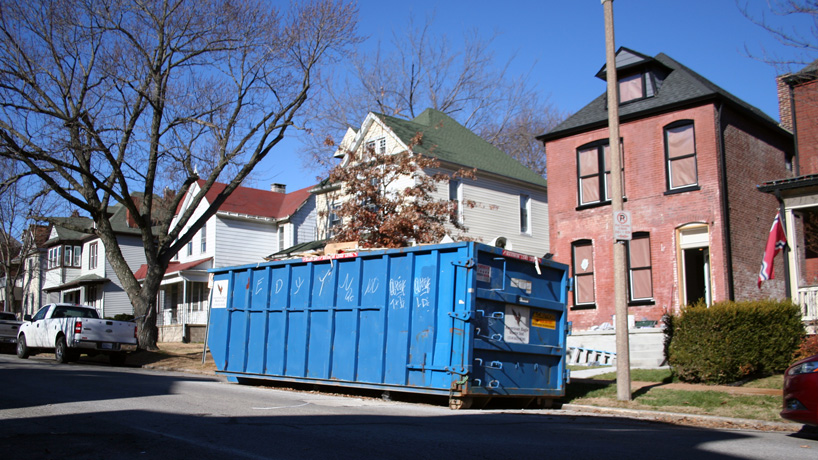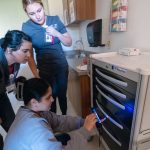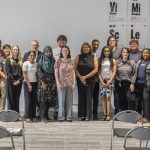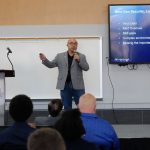
A new grant from from RRF Foundation for Aging will help the Community Innovation and Action Center and its partners study the home repair needs of older adults in St. Louis. In an older city, with much of the housing stock built before 1939, St. Louis residents often incur significant repair costs to keep their homes comfortable and safe to live in. (Photo by Jessica Rogen)
Installing an extra handle in the bathroom or a ramp to bypass the front steps are modest repairs that can dramatically increase someone’s comfort level in their home and make it easier for them to stay there longer.
But those aren’t the only repair needs older adults might encounter as they live in their homes. Leaky roofs, plumbing problems, poor lighting and malfunctioning heating and cooling systems also can create anxiety and often come with significant costs. For homeowners living on fixed – and often inadequate – incomes, these large or emergency home repairs can be difficult, if not impossible, to afford. They can force individuals to seek other housing unless they have access to support services to help cover the cost.
Staff members at the Community Innovation and Action Center at the University of Missouri–St. Louis are eager to gauge the scope of these problems in St. Louis and determine what impact investment in home repair could have for older residents.
Working with several community partners – Legal Services of Eastern Missouri, the St. Louis City Senior Fund, the St. Louis Vacancy Collaborative, the St. Louis Association of Community Organizations, the St. Louis Community Development Administration, Mission St. Louis and Rebuilding Together St. Louis – CIAC applied for and received a $178,000 grant from the RRF Foundation for Aging to conduct a study of the repair needs of older adults in the city of St. Louis.
“There’s very little research on whether more major repairs make sense,” said Todd Swanstrom, the E. Desmond Lee Endowed Professor of Community Collaboration and Public Policy Administration at UMSL, who is part of the team conducting the research. “What effect do they have? If somebody has a leaky roof, if we repair that roof, will they stay longer in their home? ‘Aging in place,’ a common phrase used to describe the ability of older adults to remain in their homes, is a lifestyle that many prefer, and research has shown it has many benefits. Especially in the age of COVID, forcing older adults to move into nursing homes can be problematic.”
The initial interest in this project began more broadly out of a desire to understand the extent of home repair needs in St. Louis, particularly those that homeowners cannot afford. It is an older city with much of its housing stock built before 1939, and it has increasingly struggled with issues of vacancy, particularly in lower-income neighborhoods.
“Legal Services of Eastern Missouri and the Vacancy Collaborative had been discussing needs for more free to low-cost home repair programs for some time and realizing that we don’t have data on the full scope of the need,” CIAC interim co-Director Kiley Bednar said. “It’s hard to make the case for funding home repairs if you don’t have the full picture of how much is needed.”
RRF Foundation for the Aging provided an avenue to support that research. The nonprofit based in Chicago has a 40-year history investing in programs and research aimed at improving the quality of life for older people.
The best way to fully understand the home repair needs is to send skilled inspectors into each home to inspect the plumbing and look for rotting floorboards or holes in the roof. But that is a costly enterprise.
The Federal Reserve Bank of Philadelphia found a way to scientifically estimate the extent of the problem in a national study they did with data gathered in the American Housing Survey. That survey doesn’t produce enough samples to hone in on one particular city, but CIAC and its partners will be taking a similar approach as they construct their own mail questionnaire they will begin sending to some 2,000 older adult homeowners in January.
The survey will ask about the experiences people have in their homes, such as if they feel cold in the winter months or if they have difficulty flushing the toilet.
“Our goal is that the methodology could be replicable for another city of similar size that is grappling with these same questions,” Bednar said. “We think they could take what we’ve done, some of the foundational research, and then apply it to their own city and their own data.”
There are many actors working on home repair in St. Louis, but there is currently no coordinated strategy. The hope is this research will increase awareness and lead to a more intentional approach to fundraising for and supporting home repairs.
The partners are also conscious of addressing equity because St. Louis’ history of redlining has led to unequal investment or disinvestment in many predominantly Black communities.
“It is clear that we are focusing on those who need help,” Swanstrom said. “We’re going to oversample parts of the city with lower incomes and more need for home repair loans because the groups we’re working with give either grants to do the home repairs or forgivable loans.”
He and Bednar believe the involvement of so many organizations in the grant application has left them well positioned to effect change.
“RRF Foundation for Aging were intrigued by our design, but they were really impressed that we had the right partners at the table and that it’s research that has the potential to directly impact policy,” Bednar said. “Many organizations in St. Louis are looking at this issue. They are currently funding some home repair, but they’re struggling to meet the demand for those services. There’s a potential window within some of their larger planning efforts to have more funding, more strategic funding.
“If you’re going to spend dollars, where should we spend the dollars? We need to be ready with information that can inform and impact local policy.”














